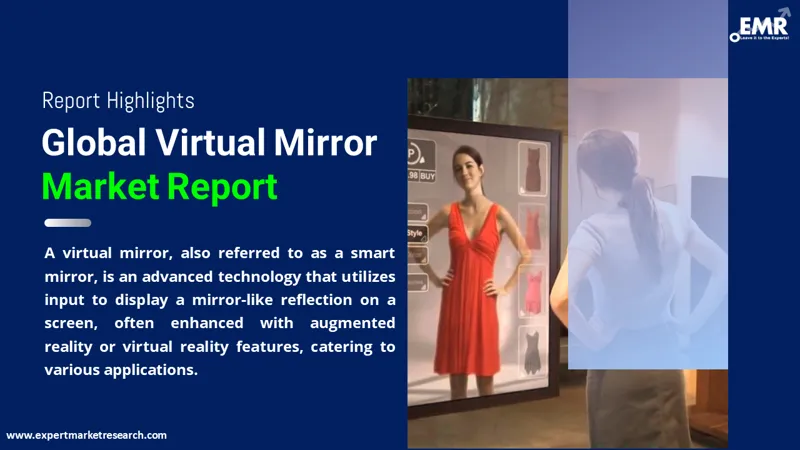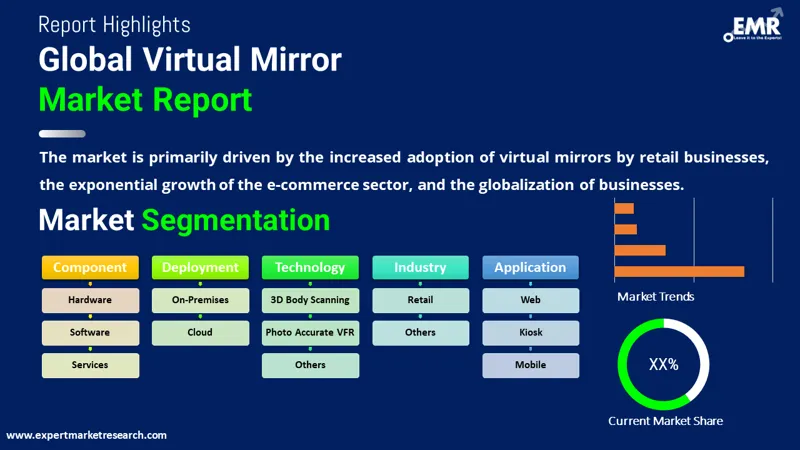
Consumer Insights
Uncover trends and behaviors shaping consumer choices today
Procurement Insights
Optimize your sourcing strategy with key market data
Industry Stats
Stay ahead with the latest trends and market analysis.
Trending Now



The global virtual mirror market value reached around USD 10.47 Billion in 2024. This growth is driven by several factors, including the integration of augmented reality (AR) technology, which allows consumers to virtually try on products, enhancing their shopping experience. For instance, L'Oréal has developed virtual makeup try-on solutions that enable users to see how different products look on their skin in real-time. The industry is expected to grow at a CAGR of 24.70% during the forecast period of 2025-2034 to attain a value of USD 95.19 Billion by 2034. Retailers like Zara are also using virtual mirrors in stores to help customers envision outfits without the need for physical try-ons.
Base Year
Historical Year
Forecast Year






Value in USD Billion
2025-2034
Virtual Mirror Market Outlook
*this image is indicative*

Read more about this report - REQUEST FREE SAMPLE COPY IN PDF
Virtual mirror, also known as a smart mirror, is a technology that uses input to show a mirror-like reflection on a display screen, which can be supplemented with augmented reality or virtual reality, based on desired applications. This technology is commonly used in the retail sector as it enables users to virtually try a piece of clothing or ornament without physically wearing the product. Virtual mirrors enable retail businesses to scale-up their operations at an international level which can boost profitability. Hence, this factor is leading to a rapid transition from conventional to online shopping methods, further fuelling the growth of the virtual mirror market.
The market is also growing due to advancements in augmented reality (AR) and artificial intelligence (AI) technologies, which enable highly realistic and interactive virtual try-on experiences. As online shopping continues to rise, consumers are increasingly seeking tools to replicate in-store experiences, driving demand for virtual mirrors in industries like fashion and beauty. For instance, major beauty brands like Sephora and L'Oréal have incorporated AR-powered virtual mirrors to allow customers to try on makeup virtually. This has boosted online sales, which in turn, positively impacts virtual mirror market revenue. Additionally, fashion retailers such as ASOS and Adidas have adopted virtual mirrors for clothing and accessory try-ons to reduce return rates and enhance customer engagement. These trends are supported by studies showing that virtual try-on solutions can increase conversion rates by up to 90% and reduce return rates by 25%.
Rising integration of modern technologies, growth of e-commerce, and rising demand for contactless shopping are the key trends propelling the market growth.
AR technology is transforming the virtual mirror market, allowing customers to engage with products innovatively. For example, L’Oréal reported a 150% increase in virtual try-ons in 2023, with over 100 million sessions of digital try-ons compared to 40 million in 2022. This uptick reflects consumers' growing preference for immersive shopping experiences. The company’s acquisition of AR firm ModiFace has enabled it to offer virtual makeup and hair color try-ons, enhancing customer interaction and driving sales growth. Government data indicates that such AR applications significantly boost consumer engagement and satisfaction in retail environments.
Increasing incorporation of advanced technologies within virtual mirrors, such as artificial intelligence, virtual reality, and augmented reality, is significantly enhancing the capabilities and features of virtual mirrors, thereby supporting virtual mirror market expansion. These technologies allow virtual mirrors to deliver more realistic and interactive experiences. For instance, L’Oréal’s AR-powered "ModiFace" enables users to try on makeup products virtually, which led to a reported 27% increase in customer engagement on their online platform. Similarly, Ray-Ban’s virtual try-on feature, powered by AR, allows users to see how different eyewear styles look on their faces, which has reduced return rates by up to 30%.
The rise of e-commerce has intensified the need for virtual mirrors to enhance online shopping experiences. IKEA’s Place app allows users to visualize furniture in their homes using AR, reducing uncertainty in online purchases. L’Oréal's e-commerce sales accounted for 28% of total sales in 2022, reflecting its strategic focus on online channels. In China, e-commerce represents more than 26% of L’Oréal’s sales, showcasing the importance of integrating virtual mirror technology into e-commerce platforms to meet evolving consumer expectations.
The demand for contactless shopping solutions has surged due to hygiene concerns. Retailers like H&M have installed smart mirrors equipped with voice assistants that allow customers to take selfies and receive outfit recommendations without physical contact. Additionally, L’Oréal’s AR initiatives have contributed to its digital transformation strategy, with an estimated annual ICT spending of $643.1 million in 2023 focused on enhancing customer experiences through technology. Government publications emphasize that these innovations not only enhance customer safety but also improve overall shopping experiences.
Progressive product launches initiated by leading market players, aimed towards developing improved versions of virtual mirror solutions with more personalised experiences and greater browsability of new products, is one of the key trends in virtual mirror market. Sephora, for example, launched an upgraded virtual mirror solution with improved AI capabilities to allow users to receive recommendations based on their facial features and preferences. Furthermore, fashion retailer ASOS introduced a virtual try-on feature that allows customers to view new clothing collections in a highly interactive manner and thereby, increases the likelihood of purchase by 40%.
Another trend is the product’s rising use across various industries. Virtual mirrors are increasingly used beyond traditional retail settings. For instance, Adidas has implemented smart mirrors in its Oxford Street store that detect products and display them in various sizes and colors, enhancing customer interaction. In the automotive sector, Vespa's AR app allows users to customise scooters by overlaying digital models onto real-world images through their smartphones.
In 2024, the market is ripe with opportunities. Brands are using products like virtual mirrors to provide tailoured recommendations, drive customer engagement, and boost conversion rates. As per industry reports, customers are 70% more likely to make a purchase when presented with personalised product suggestions through virtual try-ons. Additionally, the rapid growth of wearable AR/VR devices provides a lucrative avenue for the virtual mirror market development, as these devices can be paired with virtual mirrors. Major brands like Nike are exploring virtual mirrors integrated with body-scanning technology to help users find the perfect fit and to reduce return rates by an estimated 20%. Moreover, with a growing number of companies focusing on sustainability, virtual mirrors also offer a unique opportunity to reduce waste by minimising the need for physical samples in retail stores.
One of the main restraints in the market is the high cost of implementation. The initial investment in advanced technologies like artificial intelligence (AI), augmented reality (AR), and virtual reality (VR), as well as the need for ongoing maintenance, can exceed USD 100,000 for a single setup. Furthermore, while internet accessibility has improved globally, high-speed connectivity is still limited in some regions, restricting the full functionality of virtual mirrors in these areas. For instance, only about 60% of households worldwide have access to high-speed internet. In Africa, less than 40% of the population has access to high-speed internet, and even in the United States, 23% of rural households lack adequate high-speed connectivity. These limitations significantly impact the virtual mirror market dynamics and trends, as they require stable and fast internet to deliver real-time experiences. Additionally, a 2024 survey found that around 35% of users reported issues with accuracy and responsiveness in virtual mirrors, leading to dissatisfaction and reduced product demand. Lastly, privacy concerns also act as a restraint, as some consumers are hesitant to use these mirrors due to worries about data security, biometrics, and facial recognition technology.

Read more about this report - REQUEST FREE SAMPLE COPY IN PDF
“Virtual Mirror Market Report and Forecast 2025-2034” offers a detailed analysis of the market based on the following segments:
Market Breakup by Component
Market Breakup by Deployment
Market Breakup by Technology
Market Breakup by Industry
Market Breakup by Application
Market Breakup by Region
Market Insights by Component
The software segment accounts for a healthy share of the market, owing to its heightened application across the retail sector. Virtual mirror software reduces the time spent on rushing into a trial room, enables enhanced inventory management, optimises space, and facilitates efficient segregation of different products. L’Oréal's ModiFace, for example, enables virtual makeup try-ons, reportedly increasing customer engagement by 27% in both online and in-store settings.
On the other hand, hardware components like sensors, displays, and cameras enable the interactive functionality of virtual mirrors. As per virtual mirror industry analysis, retailers in USA have implemented AR-powered kiosks to increase customer engagement by up to 50% in stores. These advancements are particularly valuable for applications in fashion and automotive sectors.
Market Insights by Deployment
On-premises virtual mirrors are preferred for their enhanced data security and control. This setup also delivers faster performance as it isn't dependent on internet connectivity. This makes them ideal for real-time applications in retail environments. The U.S. retail sector benefits from this deployment due to stringent privacy regulations (California Consumer Privacy Act (CCPA) and the need for high-speed interaction in-store.
Cloud-based virtual mirrors, however, are popular for their scalability, lower upfront costs, and remote accessibility, allowing retailers to offer virtual try-ons on mobile apps and e-commerce sites globally. As per virtual mirror market analysis, this approach supports seamless integration with data analytics tools and help businesses understand customer preferences. In 2024, the Asia-Pacific region saw a 30% growth in cloud-based virtual mirrors, driven by e-commerce giants like Alibaba and Amazon, which leverage the cloud to provide virtual try-on features to millions of users across multiple regions.
Market Insights by Technology
Amongst technologies, 3D body scanning technology is used to provide highly accurate virtual try-ons, particularly in fashion and retail. Companies using 3D body scanning see up to a 25% reduction in returns, as the technology helps customers choose the correct size with high precision. Other reports also highlight its use in fitness sectors where personalised training and body metrics tracking are growing in demand. Brands like Nike and Macy use this technology, which has also boosted virtual mirror market value.
Photo accurate VFR segment is often used in automotive and aviation industries to provide accurate views for vehicle design and safety assessments. As per industry reports, this technology helps reduce development costs and time by up to 30% compared to traditional methods. VFR technology has seen growing adoption in regions like Europe, where it helps brands like Audi simulate exterior views on vehicles.
Leading in virtual mirror market share, 3D AR/VR offers immersive virtual experiences in retail industries. Deloitte projects that AR/VR could drive up to 40% sales growth in e-commerce by 2025 and companies like Sephora, Gucci, and IKEA are leading the charge with AR-enhanced try-ons and virtual stores. For instance, Gucci's AR lens allows customers to visualise sneakers on their feet via Snapchat. Moreover, government of China is actively funding AR/VR developments by offering grants of up to USD 1.45 million for tech innovation hubs. Similarly, in 2024, 3D AR/VR adoption in North America led to a 30% increase in virtual try-on capabilities for companies like Sephora and IKEA, who use this technology to engage customers and improve online sales conversion rates by up to 40%.
Market Insights by Industry
Based on industry, the retail segment is likely to be the fast-growing segment in the forecast period, driven by the global expansion of the e-commerce sector. For e-commerce, virtual mirrors available on Amazon, Myntra, Alibaba, Lenskart enable customers to virtually try on products, from clothing to eyewear, significantly reducing return rates by up to 25%. By trying on products through virtual mirrors, customers can gain greater confidence regarding their purchase, thereby reducing the need for time-consuming and hectic returns, and increasing customer satisfaction and retention. Moreover, increasing number of online shoppers, projected to reach 2.1 billion in FY 2024, has enlarged the share of retail sector in the virtual mirror market.
Also, studies indicate that virtual try-on features can increase online conversion rates by up to 40%. Shopify reports that 66% of shoppers feel more confident in purchases when they can try items virtually. Furthermore, the rapid expansion of smartphone usage, predicted to exceed 6.3 billion devices worldwide by 2025, supports the adoption of mobile-friendly AR applications, further propelling the virtual mirror market growth.
In brick-and-mortar stores, virtual mirrors allow shoppers try on makeup, accessories, or outfits without physically changing items. This trend is part of the growing "phygital" movement, where physical and digital experiences are blended to attract tech-savvy shoppers. Major retailers like Sephora and Nike have reported up to a 7% increase in online sales after in-store virtual mirror adoption. With more than 92% of retailers maintaining a physical presence, brick-and-mortar stores are leveraging virtual mirrors to drive foot traffic back to physical locations.
Market Insights by Application
Virtual mirrors on e-commerce websites allow shoppers to try on products digitally, enhancing online shopping experiences. Platforms like Amazon and Alibaba recently reported that virtual try-on tools have led to a 40% increase in user engagement, which in turn, has increased virtual mirror demand growth.
In contrast, interactive kiosks in physical stores offer in-person customers a way to virtually try on products. Retailers like Nike and H&M have incorporated AR-based kiosks in stores, which reportedly help increase footfall and reduce return rates by around 25%. With post-pandemic demand for contactless solutions, kiosks equipped with voice-activated and gesture-based interactions are becoming more popular in high-traffic areas like malls and airports.
However, mobile applications are the fastest-growing segment, allowing users to access virtual mirrors on the go. Apps such as Sephora’s Virtual Artist provide AR-based makeup try-ons, which have led to a 27% increase in customer satisfaction. These solutions are widely used by younger consumers.
North America Virtual Mirror Market Trends
North America leads the market, driven by the widespread adoption of augmented reality (AR) and artificial intelligence (AI) technologies in retail. For example, Sephora in the U.S. has implemented AR-powered virtual mirrors, enabling customers to try on makeup products virtually through its mobile app and in-store displays. In addition, Warby Parker offers virtual try-on features for eyeglasses, allowing users to see how different frames look on their faces using AR technology. High technology adoption rates in the U.S. and Canada support the expansion of virtual mirrors. As per industry reports, over 60% of U.S. retailers, such as Ulta Beauty and Macy’s, are incorporating virtual try-on technology as part of their strategy to enhance customer experience and drive sales.
Asia Pacific Virtual Mirror Market Drivers
The Asia Pacific region is seeing rapid growth in the market due to the digital transformation in countries like China, Japan, and South Korea. Alibaba’s Taobao has launched virtual try-on options for fashion and cosmetics, where shoppers can visualise products on themselves before purchasing. In China, L'Oréal partnered with Meitu, a popular beauty app, to allow users to try on makeup virtually. Over 75% of Chinese beauty consumers have engaged with these AR features when shopping online. Social media platforms like WeChat and Line are also widely used for virtual shopping experiences. Moreover, government-backed initiatives promoting digital innovation, such as Japan's Society 5.0, provide additional virtual market opportunities.
Europe Virtual Mirror Market Dynamics
Europe has a mature market for virtual mirrors, with high adoption across industries like fashion, automotive, and retail. For example, H&M, Zara, and Ralph Lauren in the United Kingdom offers virtual fitting rooms, which enables customers to try on clothing items through their smartphones. Similarly, L'Oréal Paris in France provides virtual try-ons for hair colour products. Approximately 50% of online shoppers in Germany engage with augmented reality tools, such as those offered by Zalando, to assist with decision-making. Additionally, BMW in Germany has adopted virtual mirror technology in showrooms to allow customers to picture vehicles before making purchases.
Latin America Virtual Mirror Market Growth
The market in Latin America is emerging due to the growth of e-commerce in Brazil and Mexico. Natura, a Brazilian cosmetics company, introduced virtual try-on features for its makeup line. Similarly, Falabella in Chile is using AR mirrors in its department stores for customers to try on beauty products virtually. In Brazil, approximately 40% of beauty product consumers have used virtual try-on tools before making a purchase. This reflects a growing interest in digital shopping experiences. Moreover, as smartphone usage and internet connectivity is improving across LATAM, retailers such as Liverpool in Mexico, are also adopting this technology to drive profits.
Start-ups are focusing on creating accessible and cost-effective virtual mirrors to meet growing consumer demands for immersive online shopping experiences. They are using advanced technologies like AI, AR, and machine learning to enhance accuracy and realism in virtual try-ons. Many start-ups are also focusing on making mobile compatible virtual mirrors to enable seamless integration for retailers of all sizes. Start-ups that have worked towards creating a favourable virtual mirror market outlook are:
ModiFace was founded in 2006 and is headquartered in Toronto, Canada. It offers virtual try-on tools that enable users to experiment with makeup, hair colour, and skincare products in real-time. ModiFace's technology powers virtual mirrors for major brands, including L’Oréal, Sephora, and Estée Lauder. It was acquired by L'Oréal in 2018 and since then, it has become a leader in AR beauty tech, with its tools reportedly increasing online customer engagement by up to 27%. Currently, its platform supports over 250 million virtual try-ons globally.
Vue.ai was established in 2016 and is based in California, United States. It provides AI-based solutions for fashion retail, such as virtual styling and product tagging. Its virtual mirror tools allow users to imagine apparel and accessories on digital avatars. As per virtual mirror market report, company’s solutions are used by Macy's and Tata Cliq. The company is renowned for helping clients increase conversion rates by 40% and reduce return rates by up to 30%. In 2023, Vue.ai processed over 2 billion product recommendations across its client network.
Market players are primarily focused on improving customer experiences. Companies like L'Oreal use AI-driven virtual try-on technology to allow customers to experiment with makeup looks in real-time. Similarly, Sephora's Virtual Artist app enables users to see how products look on their skin before making a purchase. This shift towards virtual tools not only boosts customer engagement but also reduces reliance on physical inventory, leading to cost savings. Zalando, a European online fashion retailer, also leverages virtual mirrors to reduce the need for physical inventory and improve overall operational efficiency. Additionally, partnerships and collaborations among key players, such as Snapchat and Gucci have led to innovative AR experiences, expanding virtual mirror market presence.
ViuBox (SenseMi) is a leading software company which offers smart retail solutions under the brand name ViuBox. Founded in 2016 and headquartered in Dubai in the United Arab Emirates, this company caters to the demands of the fashion e-commerce sector.
Reactive Reality AG offers augmented reality (AR) solutions for the fashion e-commerce sector. It was founded in 2014 and is headquartered in Austria, Europe. The company’s flagship product, PICTOFiT, has and still allows many users to create photorealistic 3D avatars for virtual try-ons, contributing to virtual mirror market growth.
Cisco Systems, Inc. is a prominent networking company which manufactures networking equipment and related services, offering a variety of products for access networking, network security, and industrial IoT, among others. It was founded in 1984 and is headquartered in California, United States.
MySizeID is a software company offering AI-powered apparel sizing and digital experiences. Established in 1999 and headquartered in Golan, Israel, it offers innovative tools that aid online retailers in increasing sales, catering to fashion, package and parcel, and DIY clients.
*Please note that this is only a partial list; the complete list of key players is available in the full report. Additionally, the list of key players can be customized to better suit your needs.*
Other virtual mirror market players include Integrated Active Monitoring Pvt. Ltd. (IAM), DigitalDM, AstraFit (Autumn Rock Limited), Vimage Srl, MemoMi Labs Inc., and Fitnect, among others.
*While we strive to always give you current and accurate information, the numbers depicted on the website are indicative and may differ from the actual numbers in the main report. At Expert Market Research, we aim to bring you the latest insights and trends in the market. Using our analyses and forecasts, stakeholders can understand the market dynamics, navigate challenges, and capitalize on opportunities to make data-driven strategic decisions.*
Get in touch with us for a customized solution tailored to your unique requirements and save upto 35%!
In 2024, the market reached an approximate value of USD 10.47 Billion.
The market is assessed to grow at a CAGR of 24.70% between 2025 and 2034.
The market is estimated to witness healthy growth in the forecast period of 2025-2034 to reach a value of around USD 95.19 Billion by 2034.
The heightened adoption of virtual mirror by retail business, exponential growth of the e-commerce sector, and globalisation of businesses are the major drivers of the market.
The key trends in the market include the increasing use of artificial intelligence and augmented reality in virtual mirrors, and progressive product launches by leading market players, and greater browsability of new products.
Hardware, software, and services are the significant components of virtual mirrors in the market.
On-premises and cloud are the major deployment types of virtual mirrors.
Key players in the market are ViuBox (SenseMi), Cisco Systems, Inc., MySizeID, Integrated Active Monitoring Pvt. Ltd. (IAM), DigitalDM, Reactive Reality AG, AstraFit (Autumn Rock Limited), Vimage Srl, MemoMi Labs Inc., and Fitnect, among others.
Explore our key highlights of the report and gain a concise overview of key findings, trends, and actionable insights that will empower your strategic decisions.
| REPORT FEATURES | DETAILS |
| Base Year | 2024 |
| Historical Period | 2018-2024 |
| Forecast Period | 2025-2034 |
| Scope of the Report |
Historical and Forecast Trends, Industry Drivers and Constraints, Historical and Forecast Market Analysis by Segment:
|
| Breakup by Component |
|
| Breakup by Deployment |
|
| Breakup by Technology |
|
| Breakup by Industry |
|
| Breakup by Application |
|
| Breakup by Region |
|
| Market Dynamics |
|
| Competitive Landscape |
|
| Companies Covered |
|
Datasheet
One User
USD 2,499
USD 2,249
tax inclusive*
Single User License
One User
USD 3,999
USD 3,599
tax inclusive*
Five User License
Five User
USD 4,999
USD 4,249
tax inclusive*
Corporate License
Unlimited Users
USD 5,999
USD 5,099
tax inclusive*
*Please note that the prices mentioned below are starting prices for each bundle type. Kindly contact our team for further details.*
Flash Bundle
Small Business Bundle
Growth Bundle
Enterprise Bundle
*Please note that the prices mentioned below are starting prices for each bundle type. Kindly contact our team for further details.*
Flash Bundle
Number of Reports: 3
20%
tax inclusive*
Small Business Bundle
Number of Reports: 5
25%
tax inclusive*
Growth Bundle
Number of Reports: 8
30%
tax inclusive*
Enterprise Bundle
Number of Reports: 10
35%
tax inclusive*
How To Order
Our step-by-step guide will help you select, purchase, and access your reports swiftly, ensuring you get the information that drives your decisions, right when you need it.

Select License Type
Choose the right license for your needs and access rights.

Click on ‘Buy Now’
Add the report to your cart with one click and proceed to register.

Select Mode of Payment
Choose a payment option for a secure checkout. You will be redirected accordingly.
Gain insights to stay ahead and seize opportunities.

Get insights & trends for a competitive edge.

Track prices with detailed trend reports.

Analyse trade data for supply chain insights.

Leverage cost reports for smart savings

Enhance supply chain with partnerships.

Connect For More Information
Our expert team of analysts will offer full support and resolve any queries regarding the report, before and after the purchase.
Our expert team of analysts will offer full support and resolve any queries regarding the report, before and after the purchase.
We employ meticulous research methods, blending advanced analytics and expert insights to deliver accurate, actionable industry intelligence, staying ahead of competitors.
Our skilled analysts offer unparalleled competitive advantage with detailed insights on current and emerging markets, ensuring your strategic edge.
We offer an in-depth yet simplified presentation of industry insights and analysis to meet your specific requirements effectively.



Australia
63 Fiona Drive, Tamworth, NSW
+61-448-061-727
India
C130 Sector 2 Noida, Uttar Pradesh 201301
+91-723-689-1189
Philippines
40th Floor, PBCom Tower, 6795 Ayala Avenue Cor V.A Rufino St. Makati City,1226.
+63-287-899-028, +63-967-048-3306
United Kingdom
6 Gardner Place, Becketts Close, Feltham TW14 0BX, Greater London
+44-753-713-2163
United States
30 North Gould Street, Sheridan, WY 82801
+1-415-325-5166
Vietnam
193/26/4 St.no.6, Ward Binh Hung Hoa, Binh Tan District, Ho Chi Minh City
+84-865-399-124
United States (Head Office)
30 North Gould Street, Sheridan, WY 82801
+1-415-325-5166
Australia
63 Fiona Drive, Tamworth, NSW
+61-448-061-727
India
C130 Sector 2 Noida, Uttar Pradesh 201301
+91-723-689-1189
Philippines
40th Floor, PBCom Tower, 6795 Ayala Avenue Cor V.A Rufino St. Makati City, 1226.
+63-287-899-028, +63-967-048-3306
United Kingdom
6 Gardner Place, Becketts Close, Feltham TW14 0BX, Greater London
+44-753-713-2163
Vietnam
193/26/4 St.no.6, Ward Binh Hung Hoa, Binh Tan District, Ho Chi Minh City
+84-865-399-124
Share